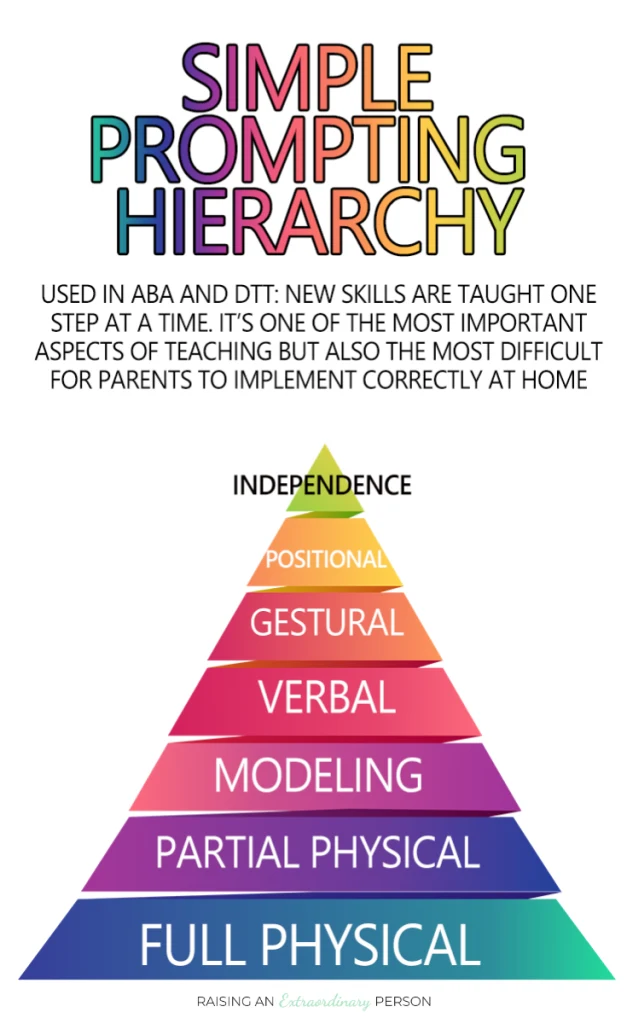Prompting, using a prompt hierarchy, is a strategy used in both ABA therapy and discrete trial training (DTT) for teaching new skills with simplified and structured steps for children with autism.
In other words, using prompts, new skills are taught one step at a time, before combining the steps to complete the whole skill. There is a simple prompt hierarchy used to guide children to independence with these new skills.
How to Use a Prompt Hierarchy With Autistic Children to Encourage Independence
Prompting is one of the most important aspects of teaching new skills to children with autism.
However, it is also one of the most difficult strategies for parents to implement and use at home consistently and correctly. This overview of a simple prompt hierarchy should help you better understand the concept.
This post is part of a 13 part series. Each post in the series will explain an evidence-based strategy used by professionals for managing behavior with children on the autism spectrum. Each part of this series will contain a table of contents so you can easily navigate to the different strategies.
Table of Contents:
- Introduction
- Build a Relationship
- Individualize Motivation
- Observe, Listen, then Join
- Optimize Language
- The Premack Principal
- Basic Redirect
- Breaks
- Picture Rehearsal
- Add Structure at Home
- Teach Independence with Prompting
- Transactional Supports
- Add Structure to the Learning Environment
What is Prompting?
Prompting is basically a way of reminding a child when to do something or how to do something correctly.
A prompt is something that is done immediately after giving the instruction to help the child perform the task correctly.
It helps clarify the expectations you have and ensures your child is successful – this is very important when your child is trying something new.
Practicing something incorrectly can impede learning how to do it correctly long term.
Prompting helps autistic children build motor memory and develop motor plans for completing tasks and activities. The goal is to fade out the prompts until your child can do the task independently.

Simple Prompt Hierarchy:
There are many different types of prompts.
Which type of prompt you choose for your child will depend on their current abilities – you want to provide enough support for your child to be successful but you do not want to do something for your child that they can do on their own.
You can look to the prompt hierarchy when deciding what level of support you should give your autistic child so they can successfully perform a task.
The Prompt Hierarchy is defined by the amount of assistance the child needs to complete the task successfully.

Note, this diagram is an example of a simple prompt hierarchy.
There are other forms of prompting that are not included in this example. The prompts covered here are some of the most commonly used.
Remember, it’s important to fade out prompts as soon as possible to prevent your child from becoming dependant on the prompt in order to complete the task.
Read more about steps for implementing a prompting hierarchy here.
Physical Prompting
Full Physical Prompting (HOH) – HOH stands for “Hand Over Hand”
This type of prompting requires you to provide physical guidance to your child to complete the task. You do this by fully moving your child’s body while they complete the task successfully.
Basically, you would put your hand over the top of their hand and guide them. But make sure you aren’t holding the object yourself at all.
It should still be in your child’s hand, you’re just guiding them with where to move it. This helps build motor memory.
HOH may be used for things like teaching the child how to use scissors, hold a pencil, and other tasks like brushing teeth or using a fork/spoon, making a sandwich, sorting shapes, etc.

Some children don’t need to begin with a full physical prompt like HOH.
Choosing prompts depends on the individual and you should always begin with the least restrictive prompt required for your child to complete the task successfully.
Partial Physical Prompting
Like the full physical prompt, during partial physical
But, this time your child has some control of their body movements as well. For example, you would guide your child by their elbows rather than having your hand directly over theirs.
When you’re using a partial physical prompt you can let your child take the lead in moving their body. However, it’s important that they avoid making any errors because the goal is to develop motor memory in completing the task.
So, you should redirect their hand/body using the partial physical at the very first sign of making a mistake.
Modeling
Modeling involves you demonstrating the correct responses or way to complete the task. During modeling, you would both verbally and physically demonstrate what you want
In order to use this form of prompting, your child must be able to successfully imitate others. Strategy 8 covers various ways of teaching imitation to help you with this.
During modeling, you would state the task, for example, “put away your toys” and then pick up one of the toys and put it away. Then have your child begin putting toys away.
If necessary, you can also add in a partial or full physical prompt during any of the steps involved. For example, if your child started to do it incorrectly, but the goal is to use the least intrusive prompt possible.
For example, after modeling you may, if required guide your child’s body in picking up a toy and putting it in the bin.
Verbal Prompts
There are two basic types of verbal prompts:
Direct Verbal Prompt – This is explicitly telling your child what to do, for example, “Pick up your toys”
Indirect Verbal Prompt – Verbally point out relevant information which will act as a cue for your child to complete the task. For example, “I see your toys laying on the floor”
Children can become dependent on verbal prompts, not doing any task/chore without being told first. It’s difficult to fade out verbal prompts – so only use them when you need to.
Gestural Prompts
Gestural prompts give your child a cue to use a skill through the use of gestures.
It could include gestures such as:
- Pointing in the correct direction
- Tapping the required materials
- Looking at the correct materials
- Tapping the child’s hand
- Pointing to the correct answer
If you are using gestural prompts with your child you should gradually increase the amount of time between giving the prompts so your child can have the opportunity to respond without being prompted.
Positional Prompt
Positional prompts can be extremely helpful as your child works towards independence. This strategy involves placing objects in a position that will help your child be successful on their own
For example, placing your child’s toothbrush and toothpaste on the bathroom counter beside the sink so they will remember to brush their teeth.
Another example could be hanging their bookbag beside the front door so they remember on their own to take it with them to school.
Visual Prompts
You can always have visual prompts in place and these do not need to be faded. They can remain as a guide for your child and may be used as a larger visual support system.
Visual prompts may include a daily visual schedule, as well as other visual prompts as reminders such as task strips, or a “stop” sign by the door.
Various forms of visual prompting are covered in bother Strategy 8 – Picture Rehearsal and Strategy 9 – Structuring The Home.
Prompt Fading
As you begin fading out prompts, be aware of your child’s processing time and begin increasing the time delay before prompting.
(Note: If you delay the prompt, does your child begin the task on their own? – they do not need the prompt you can use a less intrusive prompt or perhaps none at all)
Keep your end goal in mind as you begin prompt fading – independence.
Keep the
Children with autism can become dependent on prompting to complete tasks.
However, when it’s possible you should always have your child perform a task themself if they are physically and cognitively capable.
Note – children need to be developmentally ready to learn these skills as well – if your child is too young they won’t be developmentally ready to be taught certain skills without parental help even with the use of the prompt hierarchy.
Continue to: Strategy 11 – Transactional Support

Guide to Teaching Social-Emotional Skills With Social Scripts & Imitation
Saturday 9th of November 2019
[…] Teach Independence with Prompting […]
9 Strategies For Teaching Social Skills To ASD Children - Raising An Extraordinary Person
Monday 28th of October 2019
[…] Prompting and creating environmental cues […]
5 Tips That Make It Easier To Communicate With Your Autistic Child - Raising An Extraordinary Person
Thursday 24th of October 2019
[…] Teach Independence with Prompting […]
7 Ways to Improve Trust Between You and Your Autistic Child ·
Sunday 13th of October 2019
[…] Strategy 10: Teach Independence with Prompting […]
How to Use Breaks to Teach Self-Regulation ·
Sunday 13th of October 2019
[…] Teach Independence with Prompting […]